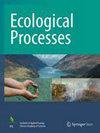Response mechanism of soil microorganisms to simulated precipitation in the source wetland of Qinghai Lake
IF 3.9
2区 环境科学与生态学
Q1 ECOLOGY
引用次数: 0
Abstract
Changes in precipitation patterns crucially impact soil microbial communities, and the ecosystem in Qinghai-Tibet Plateau (QTP) is highly vulnerable to climate change. However, we do not fully understand how soil microbial communities in the source wetlands of QTP respond to changes in precipitation. In this study, we employed advanced techniques such as high-throughput sequencing and metabolomics to investigate how soil microbial communities in a source wetland of Qinghai Lake respond to changes in precipitation after quadrennial precipitation treatment. Our findings showed that the predominant microbiota in the source wetland was Proteobacteria. Interestingly, alterations in precipitation levels, whether increased or reduced, did not significantly impact the diversity or functional groups of the microbial community. However, the structure of the microbial community did respond notably to changes in precipitation, leading to shifts in the relative abundance of Spirochaetes and Treponema. A notable finding was that reduced precipitation levels (– 25% and − 50%) and mild increases in precipitation (25%) within the region contributed to increased soil carbon content. However, this effect ceased to manifest when precipitation increased by 50%. Additionally, the reduction in precipitation prompted the release of soil metabolites like syringic acid and aldosterone, while enhanced precipitation resulted in a decrease in aldosterone content. Precipitation changes altered the relative abundance of soil microbial communities and metabolites, which was conducive to increasing carbon storage in this alpine wetland.青海湖源头湿地土壤微生物对模拟降水的响应机制
降水模式的变化对土壤微生物群落有着至关重要的影响,青藏高原的生态系统极易受到气候变化的影响。然而,我们并不完全了解青藏高原源头湿地的土壤微生物群落是如何应对降水变化的。在本研究中,我们采用了高通量测序和代谢组学等先进技术,研究了青海湖源头湿地在经过四年一次的降水处理后,土壤微生物群落是如何响应降水变化的。我们的研究结果表明,源湿地中最主要的微生物群系是变形菌。有趣的是,降水量的变化,无论是增加还是减少,都不会对微生物群落的多样性或功能群产生显著影响。不过,微生物群落的结构确实对降水量的变化做出了明显的反应,导致螺旋体和颤形菌的相对丰度发生了变化。一个值得注意的发现是,该地区降水量的减少(- 25% 和 -50%)和降水量的轻度增加(25%)导致了土壤碳含量的增加。然而,当降水量增加 50%时,这种效应就不再明显。此外,降水量的减少促使土壤代谢产物如丁香酸和醛固酮的释放,而降水量的增加则导致醛固酮含量的减少。降水量的变化改变了土壤微生物群落和代谢产物的相对丰度,有利于增加这片高山湿地的碳储存。
本文章由计算机程序翻译,如有差异,请以英文原文为准。
求助全文
约1分钟内获得全文
求助全文
来源期刊

Ecological Processes
Environmental Science-Ecological Modeling
CiteScore
8.50
自引率
4.20%
发文量
64
审稿时长
13 weeks
期刊介绍:
Ecological Processes is an international, peer-reviewed, open access journal devoted to quality publications in ecological studies with a focus on the underlying processes responsible for the dynamics and functions of ecological systems at multiple spatial and temporal scales. The journal welcomes manuscripts on techniques, approaches, concepts, models, reviews, syntheses, short communications and applied research for advancing our knowledge and capability toward sustainability of ecosystems and the environment. Integrations of ecological and socio-economic processes are strongly encouraged.
 求助内容:
求助内容: 应助结果提醒方式:
应助结果提醒方式:


